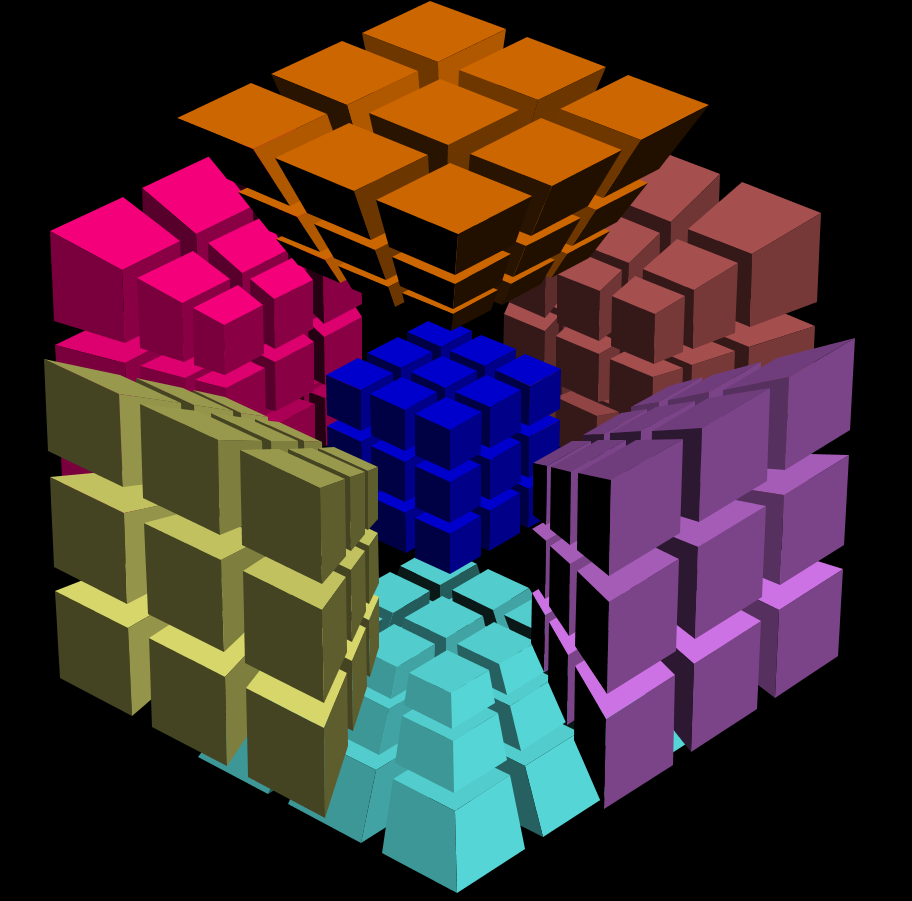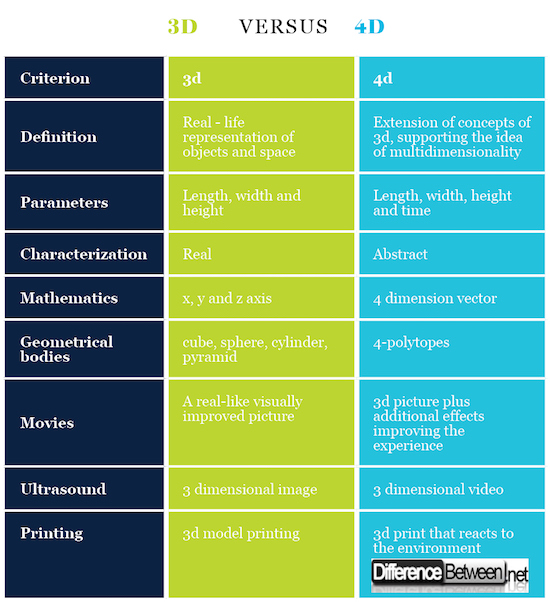Difference Between 3D and 4D
The world we experience is composed of three-dimensional space – width, depth, and height, in addition to the temporal dimension of time. But scientists have long assumed that there probably is a fourth spatial dimension that is beyond what we can experience or understand. Evidence of the existence of the fourth dimension (4D) is problematic due to the fact that we cannot directly observe anything that is outside our three-dimensional space.
What is 3D?
The three dimensional space is the geometric model of the world we live in. It is called three-dimensional, because its description corresponds to three of the unit vectors, which are the length, width, and height direction. The perception of three-dimensional space is developed at a very early age and has a direct relationship to the coordination of human movements. The depth of this perception depends on the visual ability of world awareness and the ability to recognize three dimensions with the help of the senses. The position of any point in the space is determined with respect to the three axis coordinates that have different numerical values in each given interval. The three-dimensional space at each individual point is determined by three numbers corresponding to the distance from the reference point on each axis to the point of the cross-section with the given plane.
What is 4D?
Ever mentioned “four dimensions of space,” mainly refers to Einstein’s “general relativity theory” and “special relativity” in relation to the “four dimensional space-time” concept. According to Einstein’s concept, our universe is composed of time and space. The temporal relationship between the spatial structure of a regular three-dimensional space of length, width and height of three axes also added a date, but this time the axis value is a virtual axis. Four-dimensional space is space-time concept. With three dimensions the space is shown by coordinates, while the four dimensions of the time (t) are not displayed in that coordinate system with some angle (dimensional) that is constant or real. It is real in that sense that it resembles the first three dimensions. But time has become a part of that system, in which it is presented as another dimension. Simply put, in a flat concept, it can be said that space reality is a square, not a cube. The square would lie flat and could move just left, right, forward, and back. The cube could go up and down. Thus, the three-dimensional cube is in the world ‘over’ the two-dimensional square. What about four-dimensional cubes then? It would be a tesseract, four-dimensional analog or ‘shadow’ cube. Since we are limited to a three-dimensional perspective, we cannot perceive it. Imagine the beings in a flat square at the bottom of the cube (2nd dimension). Now imagine beings in the cube above the flat square (3rd dimension). Then imagine the beings in the tesseract attached to a three-dimensional cube! These beings could also be seen within the 3rd and 2nd dimensions.
Difference Between 3D and 4D
Definition of 3D and 4D
Dimensions have been developed as the knowledge of the space increased. They are measurable things, i.e. Universe variables. The concept of flat universe reflects the idea of 2 dimensions. Our reality, however, is presented in three dimensions – everything around us is explained by its length, width and height. Adding the dimension of time as an abstract dimension leads to the idea of four dimensionality.
Parameters of 3D and 4D
3d representation is presented with three variables – length, width and height. 4d adds the time variable.
Characterization of 3D and 4D
3d presentation is a real-life factual concept. 4d is an abstract idea.
Mathematics of 3D and 4D
3d objects in mathematics are presented by 3 variables – placed on the x, y and z axis with the appropriate coordinates. 4d objects should be presented by 4 dimensional vector.
Geometrical bodies of 3D and 4D
3d objects are all around us – cylinders, cubes, pyramids, spheres, prisms... 4d geometry is much more complex – it includes 4-polytopes. An example is the tesseract – analogue of the cube.
3D and 4D Movies
3d in cinematography present an entirely new video methods including visual effects that result in three dimensional picture. A 4d movie is a 3d movie with additional effects providing a real-life experience, emitted in special cinemas.
3D and 4D Ultrasound
In case of 3d ultrasound, the sound waves generate reflections that processed in the computer software result a 3 dimensional image. 4d ultrasound is a 3d with the time aspect – live video of the record.
3D and 4D Printing
3d printing includes different material combination to create a 3d object based on a model. 4d printing results in a design the reacts to the environmental aspects.
3D Vs. 4D : Comparison Chart
Summary of 3D Vs. 4D
- The objects in real space exist in three-dimensional space and length, width and height are the three types of measurements. The three dimensional space is the geometric model of the world we live in. The perception of three-dimensional space is developed at a very early age and has a direct relationship to the coordination of human movements.
- Mathematics, physics and other disciplines introduce the concept of a multidimensional space based on scientific abstraction. As such, the concept of 4d has arrived – based on the Einstein’s theory of relativity – where the time is added as an additional variable.
- Difference Between Thermodynamics and Kinetics - June 24, 2018
- Difference Between Welding and Soldering - June 24, 2018
- Difference Between Additive Colors and Subtractive Colors - June 20, 2018
Search DifferenceBetween.net :
Leave a Response
References :
[0]Steeb, W.H. “The Nonlinear Workbook”, 5th ed. Singapore: World Scientific Publishing, 2011
[1]Banchoff, T.F. “Beyond the Third Dimension: Geometry, Computer Graphics, and Higher Dimensions”, NY: Scientific American Library Series, 1996
[2]Hinton, C.H. “A New Era of Thought”, London: Swan Sonnenschein & Co., 1888
[3]Image credit: https://en.wikipedia.org/wiki/File:4-cube_solved.png#/media/File:4-cube_solved.png
[4]Image credit: http://maxpixel.freegreatpicture.com/3d-Modeling-Box-Symbol-Illustration-3117628



